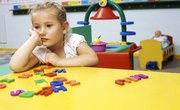Her delicious baby fat is melting away and she's ditching the diapers for Dora underwear. It's happening -- your toddler is becoming (sniff!) a big preschooler. Leaving the familiarity of her toddler program behind for a chaotic preschool classroom full of new people can be a thrilling experience for her -- or it could inspire a period of serious separation anxiety. Look on the bright side -- helping her through this will make the transition to kindergarten easier.
Timing the Transition
Deciding when to make the move shouldn't keep you up at night. Depending on your school's policies, children might age out of the toddler room at 30 months or even 3 years old. You should still have some say in the time table, and picking the right time to start can make all the difference in smoothing the process. Opt to begin the transition when she'll have a few weeks of uninterrupted school time and when things are calm at home. If you have a week-long vacation or a holiday break coming up, wait until she's been back in her toddler room for a few days before starting the shift. And if any recent changes have happened at home, like a move, new sibling or even the beginning of potty training, allow her several weeks to adjust before she begins preschool.
Making a Schedule
Shooing your toddler into a new room, waving goodbye and walking out is a simple way to ensure she'll have something to talk to her therapist about in a few years. Most kids this age will need to ease into a new room slowly over the course of several days or a week. Talk to her teachers in both classes to establish the schedule. On the first day, she should head to the preschool classroom for an hour or so, or even less if she's uncomfortable. From there, she can go to the new classroom for a few hours at a time, always starting and ending her day in her toddler class, and eventually she can leave the toddler room altogether. If she's moving between schools and this schedule isn't possible, ask if you can spend the first hour of her preschool day in the classroom with her so she can adjust with you by her side.
Helping Her Adjust
Toddlers can be as set in their ways as the curmudgeonly old man at the end of the street. She's used to her teachers, her friends and her spot at the lunch table. The change might throw her into a bit of a tailspin for a few days. She might regress and demonstrate behaviors she grew out of months earlier, or she might cling to you like a baby monkey at drop-off time. First, smother any irritation and react with nothing but affection and patience. Make preschool seem like a treat by making lists of the new things she'll learn and reading books about characters who love preschool. Honor her new big kid status by letting her pick out a new backpack or nap blanket and by throwing a celebratory dinner featuring all her favorite foods.
Potential Concerns
You're probably ready for your new preschooler to start pointing out letters and shapes and singing new songs, but you might not anticipate that she'll start pinching or try out a new naughty word. With the change in classroom comes a whole new group of children, some who might be older than your little one. She'll mimic a slew of her classmates' behaviors, both positive and negative. Respond with praise to the positive changes; try issuing a firm warning like, "That word is not allowed in our family," then ignore negative behaviors until they -- hopefully -- disappear. There's also a slim chance that she'll never gel with her classmates or that her teachers will be neglectful; if she fights going to preschool for more than a week or looks unhappy or bored when you pick her up, she might need a different program.
Related Articles
References
Resources
Writer Bio
Cooking, travel and parenting are three of Kathryn Walsh's passions. She makes chicken nuggets during days nannying, whips up vegetarian feasts at night and road trips on weekends. Her work has appeared to The Syracuse Post-Standard and insider magazine. Walsh received a master's degree in journalism from Syracuse University.











